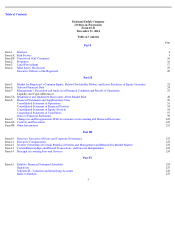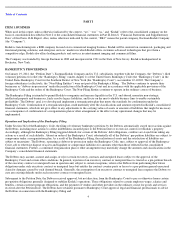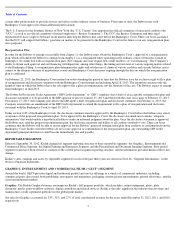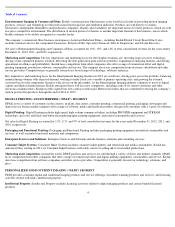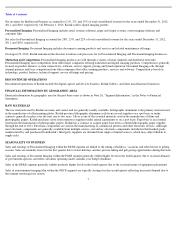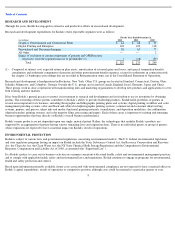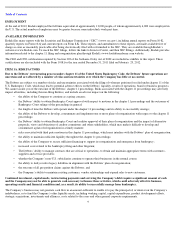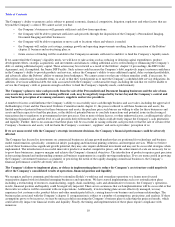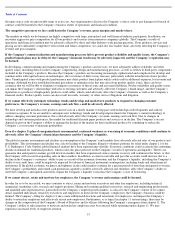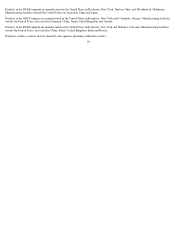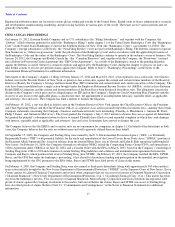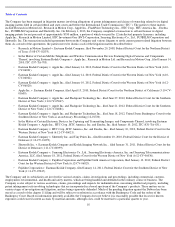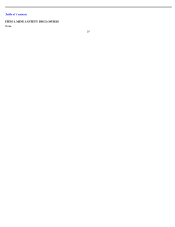Kodak 2012 Annual Report Download - page 14
Download and view the complete annual report
Please find page 14 of the 2012 Kodak annual report below. You can navigate through the pages in the report by either clicking on the pages listed below, or by using the keyword search tool below to find specific information within the annual report.
Table of Contents
filed a claim in the chapter 11 case against the Company under this guarantee alleging that the pension deficiency is approximately $2.8 billion.
The trustee of the KPP could demand that Kodak Limited fund the full pension deficiency at any time. Kodak Limited does not have assets
sufficient to fully fund the KPP deficiency if such a demand were made and not fully covered by funding received from the Company under its
guarantee. Since Kodak Limited is not a Debtor in the chapter 11 case, Kodak Limited is not protected by the stay of enforcement proceedings
applicable to the Debtors and a KPP claim against Kodak Limited will not be subject to involuntary compromise as part of the Chapter 11 plan
of reorganization. In addition, Kodak Limited has not made an annual contribution of approximately $50 million due the KPP for 2012 and this
amount could be demanded by the KPP at any time. If KPP demands payment of this amount, Kodak Limited does not have available cash to
pay it without drawing on intercompany loans to other Company subsidiaries. Kodak Limited is the largest creditor and sole equity owner of
Kodak International Finance Limited, a subsidiary that currently functions as a global cash management company and also has received
substantial advances from, and made substantial loans to, various non-U.S. subsidiaries whose liquidity is important to the continued operation
of the global group as a going concern.
The Company is in discussions with the trustee of the KPP with respect to the voluntary settlement of the KPP claims against the Company,
including Kodak Limited. If there is no voluntary settlement with the KPP, or if a voluntary settlement does not become effective or proves
incomplete or inadequate, the trustee of the KPP will, and the Pension Protection Fund and the Pension Regulator in the United Kingdom may,
have claims against Kodak Limited and potentially other Kodak group companies in addition to the claims filed by KPP against the Debtors in
the Chapter 11 cases. Prosecution of these claims could lead to the insolvent liquidation of Kodak Limited, its subsidiary Kodak International
Finance Limited and other non-U.S. subsidiaries. The insolvent liquidation of non-U.S. subsidiaries would result in the loss of control of those
subsidiaries by the Company, may disrupt global cash management, and may delay or prevent the successful restructuring of the global group as
a going concern. In addition, in the event a non-Debtor subsidiary of the Company shall become insolvent or enter insolvency proceedings, any
outstanding amount under the DIP Credit Agreement and, if applicable, Junior DIP Facility principal and interest could become immediately due
and payable.
Any settlement with the KPP must be reasonably acceptable to the DIP Facility agent and a certain majority of the Junior DIP Facility lenders,
which may make reaching such a settlement more difficult.
If we cannot continue to license or enforce the intellectual property rights on which the Company’s business depends, or if third parties
assert that we violate their intellectual property rights, the Company’s revenue, earnings, expenses and liquidity may be adversely
impacted.
We rely upon patent, copyright, trademark and trade secret laws in the United States and similar laws in other countries, and non-disclosure,
confidentiality and other types of agreements with the Company’s employees, customers, suppliers and other parties, to establish, maintain and
enforce the Company’s intellectual property rights. Despite these measures, any of the Company’s direct or indirect intellectual property rights
could, however, be challenged, invalidated, circumvented, infringed or misappropriated, or such intellectual property rights may not be sufficient
to permit us to take advantage of current market trends or otherwise to provide competitive advantages, which could result in costly product
redesign efforts, discontinuance of certain product offerings or other competitive harm. Further, the laws of certain countries do not protect
proprietary rights to the same extent as the laws of the United States. Therefore, in certain jurisdictions, we may be unable to protect the
Company’s proprietary technology adequately against unauthorized third party copying, infringement or use, which could adversely affect the
Company’s competitive position. Also, because of the rapid pace of technological change in the information technology industry, much of the
Company’s business and many of the Company’s products rely on key technologies developed or licensed by third parties, and we may not be
able to obtain or continue to obtain licenses and technologies from these third parties at all or on reasonable terms.
We have made substantial investments in new, proprietary technologies and have filed patent applications and obtained patents to protect the
Company’s intellectual property rights in these technologies as well as the interests of the Company’s licensees. There can be no assurance that
the Company’s patent applications will be approved, that any patents issued will adequately protect the Company’s intellectual property or that
such patents will not be challenged by third parties.
In addition, third parties may claim that the Company’s customers, licensees or other parties indemnified by us are infringing upon their
intellectual property rights. Such claims may be made by competitors seeking to block or limit the Company’s access to certain markets.
Additionally, in recent years, individuals and groups have begun purchasing intellectual property assets for the sole purpose of making claims of
infringement and attempting to extract settlements from large companies like ours. Even if we believe that the claims are without merit, the
claims can be time consuming and costly to defend and distract management’s attention and resources. Claims of intellectual property
infringement also might require us to redesign affected products, enter into costly settlement or license agreements or pay costly damage awards,
or face a temporary or permanent injunction prohibiting us from marketing or selling certain of the Company’s products. Even if we have an
agreement to indemnify us against such costs, the indemnifying party may be unable to uphold its contractual obligations. If we cannot or do not
license the infringed technology at all, license the technology on reasonable terms or substitute similar technology from another source, the
Company’s revenue and earnings could be adversely impacted. Finally, we use open source software in connection with the Company’
s products
and services. Companies that incorporate open source software into their products have, from time to time, faced claims challenging the
ownership of open source software and/or compliance with open source license terms. As a result, we could be subject to suits by parties
claiming ownership of what we believe to be open source software or noncompliance with open source licensing terms. Some open source
software licenses require users who distribute open source software as part of their software to publicly disclose all or part of the source code to
such software and/or make available any derivative works of
12


